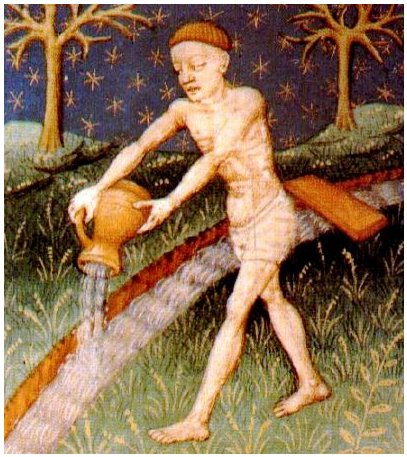At the end of the 9th month (Novem-ber) and south of the equator the end of the Eridanus 'river of sweet water' could be seen in the nakshatra sky close to Rigel (β Orionis). The cycle of time was closed and a new was about to begin - to return, ho(k)i:
In Pleione 6 (manzil day 20) the last star of the River - Cursa (β Eridani) - would perhaps bring rain to the thirsty 'island' (possibly represented by the triplet of stars in Orion's Belt or the triplet of islets outside O-rongo): I have no stars listed as rising heliacally between May 28 (with Aldebaran and Theemin) and June 3 with Hassaleh (ι Aurigae). These 5 days could have been compared to those 5 nights when Nut gave birth, when she 'created gods' (haka-ariki):
... Ma.: The deity Rongo: Ka ki atu a Tu raua ko Roko ki a Rehua. Possibly the bad (kino) dry windy season was over and its negative had arrived, the positive 'ino-'ino season of sweet rains.
Half a cycle later this good season would in turn change back to bad, change from a season of 'breadfruits' to a season of 'choking on fishbones':
Hakaraoa (choking on 'fishbones' - like dry straws) could be illustrated at right in Ca1-20. The preceding glyph could indicate the last day of 'breadfruits' - i.e. te kihikihi ('the ashes') of the good season. While Gegorian day 329 could have 'carried' a good time ahead for the Easter Islanders, the manzil day 329 could have been its opposite.
There are 348 glyphs on side b of the Mamari tablet. I have tentatively red-marked 6 'summer' months. But there are only 5 'feathers' in front in the 'watery fruit' (Ca10-3). These could be a Sign for 'fire' (rima). Added together with the 3 feathers at the back side it becomes a perfect 8. Kua hua te vai (Ca10-3) sounds very similar to 'Child of Waters' (Apam Napat, Kerb, τ Pegasi), which rose heliacally in RA day 354 (not the day before the December solstice but 80 days later): ... The name Salm (for τ Pegasi, Kerb) is also the name of the eldest son of king Fereydun, another name of which was Apam Napat ('Son of Waters'): Salm is a character in the Persian epic Shahnameh. He is the oldest son of [the] legendary hero and king Fereydun. It is believed that his name was given to him by his father, after Salm chooses to seek safety and run instead of fighting the dragon that had attacked him and his brothers (the dragon was Fereydun himself who had disguised himself to test his sons) ... When Fereydun decides to divide his kingdom among his sons, he gives Salm [the timid unmanly one] Anatolia and West [the female side of the kingdom] ... Fereydūn ... [is] also called Apam Napat, 'Son of the Waters' ... ... τ, 4.5, with ν, was Al Sufi's Sa'd al Na'amah, which Knobel thinks should be Al Na'āim, the Cross-bars over a well; but they also were known as Al Karab, the Bucket-rope. The usual titles for τ - Markab and Sagma or Salma - are from Bayer, but the last two should be Salm, a Leathern Bucket.
It was the old king who was the 'Son of Waters'. The cross-bars over the well (not drawn in the star map above) are there in order to bring up the leathern bucket (Salm) full with fresh water. Zero hour is close ahead.
But of course also the Bucket-Rope (Al Karab) was necessary. I guess Al Karab is alluding to Al Krab (the Scorpion):
The 19th Hindu station (Mula, Bunch of roots tied together, elephant goad) has 3 named stars before the unnamed star which could be the 'bucket-rope' (Al Karab), a star which in rongorongo times rose heliacally just before RA day 260. Kerb rose heliacally in RA day 354 = Gregorian day 80 + 354 - 365 = 69 = March 10 and 11 days before March 21. Its nakshatra date should be around 182 days later, in day 69 + 182 = 251 (September 8) = RA day 251 - 80 = RA day 171 (= 9 * 19). I am comparing the unnamed star (η Scorpii) with Kerb. Kerb rose heliacally in RA day 354 as if alluding to the day before the December solstice - when in reality it rose not far ahead of March equinox. South of the equator the heliacal rising of Antares in Scorpio had a similar position, not far ahead of the return of Sun. November 25 (329) = RA day 249, a number quite close to the day number (251) for Kerb. But 251 is not a RA day number but counted from January 1. On Easter Island the calendar could have begun with March 21 instead of with January 1. To count to 'the Son of Waters' could mean counting to Kerb's nakshatra date September 8 (251). South of the equator it could mean counting to Antares' RA date 249 (November 29). But then number 260 comes into play, because the nameless star, η Scorpii (259.9), rose 11 days later than Antares, reminding us of how January 1 is 11 days after the December solstice:
| |||||||||||||||||||||||||||||||||||||||||||||||||||||||||||||||||||||||||||||||||||||||||||||||||||||||||||||||||||||||||||||||||||||||||||||||||||||||||||||||||||||||||||||||||||||||||||||||||||









